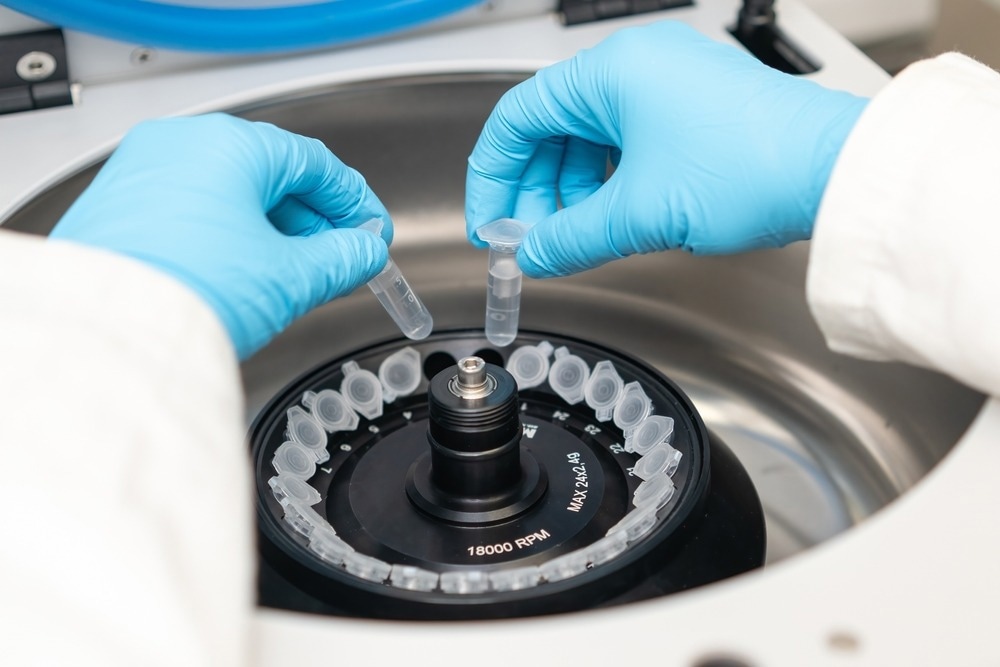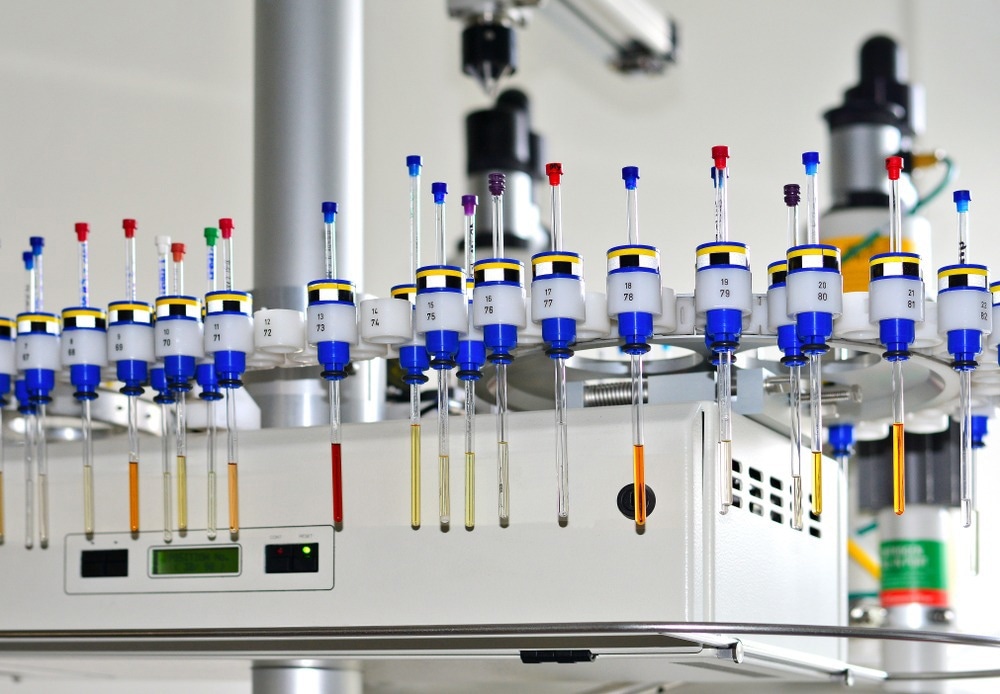Nuclear magnetic resonance (NMR) spectroscopy probes the intrinsic spin properties of nuclei and, with the proper analysis, can be used to identify local chemical environments or even the structure and dynamical behavior of biological molecules.1

Image Credit: Vladimka production/Shutterstock.com
Metabolomics is the study of metabolites – the molecular products of a metabolic process. NMR metabolomics makes use of NMR spectroscopy to identify and quantify metabolite compounds.2 While NMR metabolomics is a relatively insensitive analytical method compared to chromatography-based approaches such as GC-MS and LC-MS, the versatility of NMR metabolomics is used to study a variety of tissue types and samples, including intact tissues and organs.3
NMR metabolomics can even be used to image live tissues as it is a non-destructive analytical technique.4 For metabolomics studies, the non-destructive nature of NMR metabolomics analysis means that real-time flux analysis measurements can be performed to see if there are any short-lived biomarkers present or what potential disease mechanisms could be exploited for therapeutic purposes.
Principles of NMR Spectroscopy in Metabolomics
Typically NMR measurements are performed on a single NMR-active nuclei at a time, e.g. 13C, 1H. One of the advantages of using NMR metabolomics as opposed to other analytical measurement techniques is that, as long as an NMR-active nuclei like 31P or 15N is present, a complete chemical characterization can be performed on the metabolite by combining different NMR metabolomics experiments to gain different information.5
NMR metabolomics generally requires minimal sample preparation, and many tissues can be measured without any digestion or modification. Sometimes, for species like blood serums, there may need to be some cleanup to reduce the number of metabolites present. Alternatively, the NMR experiment can include some filters to remove some of the sample response and avoid obscuring the real signal.5
NMR machines use strong radio pulse sequences to excite transitions in particular nuclei and measure the emitted signal as they relax for their former state. Analysis of the relaxation time and frequency can then be used to create a typical NMR spectrum where peaks appear at a given chemical frequency with a splitting pattern that normally relates to the number of nearby NMR-active nuclei.
Quantification is performed by adding a known metabolite as an internal standard in the sample and measuring the relative amount of signal from the sample to the known standard level.
Advantages of NMR Metabolomics in Metabolic Profiling
Metabolic profiling often concerns correlating differences in the concentrations of metabolites that relate to an external event, such as a clinical outcome, chemical exposure or dietary change.6 Ideally, a metabolic profile would involve screening and identifying thousands of different metabolites. However, this is challenging for many samples as metabolites are often present in very different concentration ranges and few techniques will be sensitive to all of the chemical species present.
NMR metabolomics works well for metabolic profiling as the large number of different pulse sequences available can be used to select for different single types and identify individual chemical species even as part of highly complex mixtures. 1D 1H measurements can be very quick to run – taking only minutes – but more complex pulse schemes used to look at longer-range correlations or to attenuate excess protein signals can help provide a greater depth of structural information and allow for more accurate assignment. Most identification of metabolites is performed by matching measured samples to databases.
Correlations are very useful for NMR metabolomics, as spectral congestion with many overlapping peaks can be a problem even with different signal filtering schemes. The availability of statistical methods to analyze NMR data and deconvolute complex mixtures as well as the provision of automated analysis workflows, have helped the uptake of NMR metabolomics experiments.6

Image Credit: smereka/Shutterstock.com
Applications of NMR Metabolomics
As well as clinical applications to look at the response of tissues such as tumors to therapeutics, another key application of NMR metabolomics is in the agri-food sector. Plant systems are highly chemically complex and so require analysis using many of the automated tools developed from NMR metabolomics to profile which chemical species are present.
In turn, the chemical information on a plant's composition can be used to understand how plant genetics or environmental conditions influence a plant’s growth, health and development.7 Intentional design of more robust crops is a key global challenge. By screening for biomarkers for signs of plant stress, NMR metabolomics and particularly correlation-based approaches can be used to understand how to better cultivate crops.
Future of NMR Metabolomics
NMR metabolomics is already a widely used technique and has a few unique advantages, such as the screening of live tissues. However, sensitivity continues to be an inherent limitation of the method for metabolites only present in small concentrations, which is challenging to overcome without costly instrumentation or long scan times.8 NMR is arguably one of the most information-rich analytical methods, and perhaps in the future, combining NMR with other methods that can provide quicker and more sensitive analysis, where NMR provides the final discrimination for species that could otherwise not be distinguished, would be an effective approach.
Sources:
- Markwick, P. R. L., et al. (2008). Structural biology by NMR: Structure, dynamics, and interactions. PLoS Computational Biology, 4(9). doi.org/10.1371/journal.pcbi.1000168
- Emwas, A., et al. (2019). NMR Spectroscopy for Metabolomics Research. Metabolites, 9, p. 123.
- Raveton, M. (2016). Effect of organochlorine pesticides exposure on the maize root metabolome assessed using high-resolution magic-angle spinning 1 H. Environmental Pollution, 214, pp. 539–548. doi.org/10.1016/j.envpol.2016.04.057
- Calvo, N., et al. (2015). Liver fat deposition and mitochondrial dysfunction in morbid obesity : An approach combining metabolomics with liver imaging and histology. World Journal of Gastroenterology, 21(24), pp. 7529–7544. doi.org/10.3748/wjg.v21.i24.7529
- Gowda, G. A. N., & Raftery, D. (2022). NMR Based Metabolomics. Advances in Experimental Medicine and Biology, 1280, pp. 19–37. doi.org/10.1007/978-3-030-51652-9
- Garcia-perez, I., et al. (2020). Identifying unknown metabolites using NMR-based metabolic pro fi ling techniques. Nature Protocols, 15, p. 2538. doi.org/10.1038/s41596-020-0343-3
- Abreu, A. C., & Fern, I. (2020). NMR Metabolomics Applied on the Discrimination of Variables Influencing Tomato ( Solanum lycopersicum ). Molecules, 25, p. 3738. doi.org/10.3390/molecules25163738
- Edison, A. S., et al. (2017). The future of NMR-based metabolomics. Current Opinions in Biotechnology, 43, pp. 34–40. doi.org/10.1016/j.copbio.2016.08.001
Further Reading